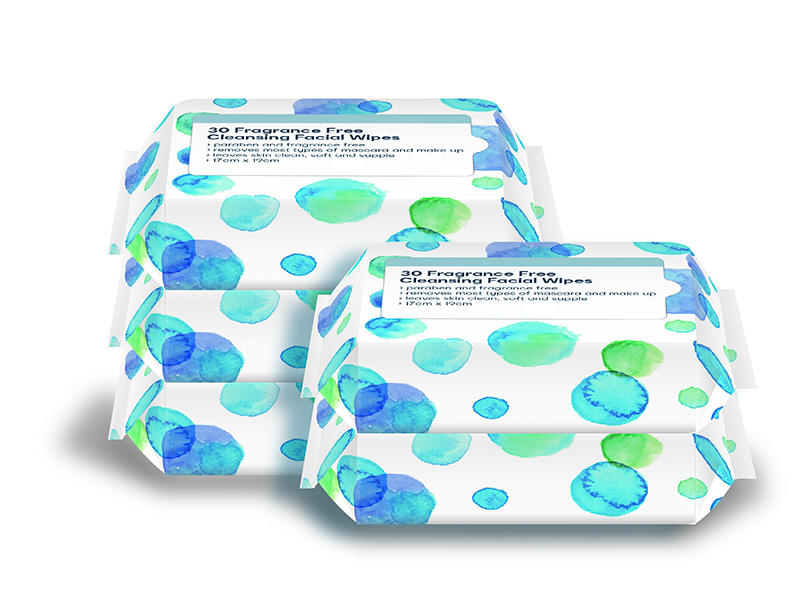In the field of sanitary products, wet wipes have become an indispensable cleaning product in consumers' daily lives due to their convenience and versatility. As the main base material of wet wipes, the unique physical properties of small-point spunlace nonwovens play a decisive role in the performance of wet wipes. From structure to function, from material to user experience, the physical properties of small-point spunlace nonwovens are highly consistent with the performance requirements of wet wipes.
1. Structural properties of small-point spunlace nonwovens and cleaning performance of wet wipes
The structural properties of small-point spunlace nonwovens are the key to meeting the cleaning performance requirements of wet wipes. This nonwoven fabric uses a spunlace process to entangle the fibers with each other to form a unique three-dimensional network structure. During the production process, high-pressure water flow impacts the fiber web, causing friction, adhesion and entanglement between the fibers, and finally forming a stable cloth-like structure.
The fibers of small-point spunlace nonwovens are arranged tightly and irregularly, and this structure gives it excellent adsorption capacity. During the use of wet wipes, the tiny pores on its surface can effectively capture dirt particles such as dust, oil, and bacteria. When the wet wipes wipe the surface of an object, the dirt will be absorbed into the pores of the non-woven fabric to achieve efficient cleaning. For example, when cleaning the desktop, the small-point spunlace non-woven fabric can quickly absorb dust and fingerprints on the desktop, making the desktop look brand new.
In addition, the structure of the small-point spunlace non-woven fabric also gives it good wear resistance. During repeated wiping, the non-woven fabric is not easy to break and can continue to maintain its cleaning ability. This wear resistance ensures that the wet wipes can still play an effective cleaning role after repeated use, and will not affect the cleaning effect or cause damage to the surface of the cleaned object due to fiber shedding.
2. Mechanical properties of small-point spunlace non-woven fabrics and wet wipes usage experience
The mechanical properties of small-point spunlace non-woven fabrics have an important influence on the use experience of wet wipes. It has good tensile strength and elongation at break, which makes the wet wipes not easy to be torn or pulled apart during use. When the user wipes the surface of the object with force, the wet wipes can withstand a certain amount of tension, maintain a complete shape, and will not be damaged, thereby ensuring the smoothness of the use process.
At the same time, the small-point spunlace nonwoven fabric also has appropriate softness. This softness mainly comes from the material of the fiber and the treatment of the fiber by the spunlace process. The appropriate softness makes the wet wipes not feel rough when they come into contact with the skin, which can bring a comfortable use experience to users. Whether wiping hands, face or baby's delicate skin, wet wipes made of small-point spunlace nonwoven fabrics can gently protect the skin and reduce skin irritation.
In addition, the resilience of small-point spunlace nonwoven fabrics is also an important manifestation of its mechanical properties. After use, the wet wipes can quickly restore part of their shape and are not easy to deform or wrinkle severely. This feature enables the wet wipes to maintain a good shape during packaging and storage, which is convenient for users to take, and also helps to maintain the uniform distribution of moisture inside the wet wipes and extend the service life of the wet wipes.
3. Water absorption and water retention properties of small-point spunlace nonwoven fabrics and moisturizing and cleaning functions of wet wipes
Water absorption and water retention properties are one of the core characteristics of small-point spunlace nonwoven fabrics to meet the performance requirements of wet wipes. Its fibers have good hydrophilicity and can absorb water quickly. During the production process, by selecting appropriate fiber raw materials and process treatment, the small-point spunlace nonwoven fabric can absorb a large amount of water in a short time and reach a saturated state. This rapid water absorption ability enables the wet wipes to quickly absorb the added cleaning liquid, moisturizing liquid and other liquid components during the production process, thereby having the functions of cleaning and moisturizing.
In addition to rapid water absorption, the small-point spunlace nonwoven fabric also has excellent water retention performance. Its three-dimensional network structure can lock the water firmly to prevent the water from evaporating too quickly. During the use of wet wipes, even after multiple wipes, the nonwoven fabric can still maintain a certain degree of wetness to ensure the continuity of the cleaning and moisturizing effects. For example, when wiping dry skin, the water in the wet wipes can replenish the skin's moisture in time, while cleaning the dirt on the skin surface, achieving the dual effects of cleaning and moisturizing.
In addition, the water absorption and water retention performance of the small-point spunlace nonwoven fabric is also closely related to the uniformity of the distribution of the liquid in the nonwoven fabric. Good water absorption and water retention performance can ensure that the liquid is evenly distributed in the nonwoven fabric, avoiding local dryness or over-wetting, so that the wet wipes maintain stable performance during use.
4. Breathability of small-point spunlace nonwovens and safety of wet wipes
The breathability of small-point spunlace nonwovens is also one of its important physical properties, which is of great significance to the safety of wet wipes. During the use of wet wipes, especially for skin cleaning, good breathability can ensure air circulation on the skin surface, avoid the skin being stuffy and humid due to the covering of wet wipes, thereby reducing the risk of bacterial growth and skin allergies.
Its unique three-dimensional network structure forms many tiny breathable channels that allow air to enter and exit freely. When the wet wipes wipe the skin, the moisture on the skin surface can be dissipated through these breathable channels to keep the skin dry. For special-purpose wet wipes such as baby wet wipes, good breathability is particularly important, which can effectively prevent skin problems such as baby diaper rash and ensure the health of the baby's skin.
5. Stability of small-point spunlace nonwovens and storage and transportation of wet wipes
The physical properties of small-point spunlace nonwovens have good stability, which is crucial for the storage and transportation of wet wipes. Under different environmental conditions, such as temperature and humidity changes, the small-point spunlace nonwoven fabric can maintain its relatively stable structure and performance. Its fibers will not shrink, deform or degrade significantly due to environmental changes, thus ensuring that the wet wipes can maintain good quality during storage and transportation.
In high temperature environments, the small-point spunlace nonwoven fabric will not melt or stick due to temperature increases; in low temperature environments, it will not become brittle and fragile. At the same time, its water absorption and retention properties, mechanical properties, etc. will not be significantly affected under normal storage and transportation conditions. This stability enables wet wipes to maintain good performance for a long time, facilitates enterprises to produce, store and sell, and also provides consumers with reliable quality products.


 中文简体
中文简体 English
English Беларуская
Беларуская 한국어
한국어 Français
Français 日本語
日本語 русский
русский Español
Español












